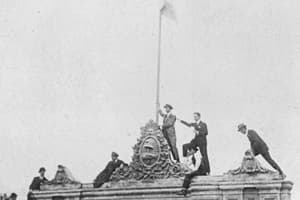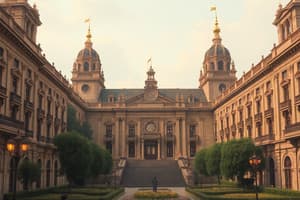Podcast
Questions and Answers
What was a major focus of Domingo Faustino Sarmiento during his presidency?
What was a major focus of Domingo Faustino Sarmiento during his presidency?
- Land redistribution
- Cultural preservation
- Indigenous rights advocacy
- Infrastructure development (correct)
What impact did the Conquest of the Desert have on indigenous populations?
What impact did the Conquest of the Desert have on indigenous populations?
- It led to their displacement and decimation. (correct)
- It improved their living conditions.
- It significantly increased their political power.
- It resulted in their integration into urban centers.
What social issue did Julio Argentino Roca's land policies exacerbate during his presidency?
What social issue did Julio Argentino Roca's land policies exacerbate during his presidency?
- Cultural conflicts among ethnic groups
- Urbanization challenges in Buenos Aires
- Social tensions due to unequal land distribution (correct)
- Educational disparities
How did the Generation of 1880 influence Argentina's development?
How did the Generation of 1880 influence Argentina's development?
What was a consequence of Argentina's economic boom in the 1880s?
What was a consequence of Argentina's economic boom in the 1880s?
What was Sarmiento's primary belief regarding education?
What was Sarmiento's primary belief regarding education?
Which demographic change did Sarmiento advocate for during his presidency?
Which demographic change did Sarmiento advocate for during his presidency?
What infrastructure developments did Sarmiento support?
What infrastructure developments did Sarmiento support?
What challenge did Sarmiento face during his presidency?
What challenge did Sarmiento face during his presidency?
Which indigenous group did Sarmiento view as representing backwardness?
Which indigenous group did Sarmiento view as representing backwardness?
What characterized Nicolás Avellaneda’s presidency?
What characterized Nicolás Avellaneda’s presidency?
What was one of the economic challenges Avellaneda faced upon taking office?
What was one of the economic challenges Avellaneda faced upon taking office?
What was the main military campaign associated with Avellaneda's presidency?
What was the main military campaign associated with Avellaneda's presidency?
What marked the beginning of Bartolomé Mitre's presidency in Argentina?
What marked the beginning of Bartolomé Mitre's presidency in Argentina?
Which conflict was Argentina involved in during Bartolomé Mitre's presidency?
Which conflict was Argentina involved in during Bartolomé Mitre's presidency?
What was one of the primary focuses of Mitre's presidency?
What was one of the primary focuses of Mitre's presidency?
What is Domingo Faustino Sarmiento recognized for in Argentine history?
What is Domingo Faustino Sarmiento recognized for in Argentine history?
Which ideology influenced Sarmiento's vision for Argentina?
Which ideology influenced Sarmiento's vision for Argentina?
How did Mitre's government view the role of Buenos Aires in the provinces?
How did Mitre's government view the role of Buenos Aires in the provinces?
What did Mitre's policies primarily aim to integrate into the national economy?
What did Mitre's policies primarily aim to integrate into the national economy?
What was one of the criticisms of the War of the Triple Alliance during Mitre's presidency?
What was one of the criticisms of the War of the Triple Alliance during Mitre's presidency?
What was one of the primary focuses of Julio Argentino Roca's presidency?
What was one of the primary focuses of Julio Argentino Roca's presidency?
What social issue arose as a consequence of land distribution during Roca's presidency?
What social issue arose as a consequence of land distribution during Roca's presidency?
How did immigration impact urban areas in Argentina during the late 19th century?
How did immigration impact urban areas in Argentina during the late 19th century?
What characterized the political landscape of Argentina after Roca's presidency?
What characterized the political landscape of Argentina after Roca's presidency?
What economic development contributed to Argentina's rise as one of the wealthiest countries in the late 19th century?
What economic development contributed to Argentina's rise as one of the wealthiest countries in the late 19th century?
What was a significant consequence of the Conquest of the Desert in terms of land ownership?
What was a significant consequence of the Conquest of the Desert in terms of land ownership?
What problem did the influx of immigrants create in urban areas during the late 1800s?
What problem did the influx of immigrants create in urban areas during the late 1800s?
What was one outcome of Roca's infrastructure development policies?
What was one outcome of Roca's infrastructure development policies?
What characterized the living conditions in parts of Argentina by the late 1800s?
What characterized the living conditions in parts of Argentina by the late 1800s?
Which political and cultural group was influential in shaping modern Argentina in the late 19th century?
Which political and cultural group was influential in shaping modern Argentina in the late 19th century?
What was a significant economic belief of the Generation of 1880?
What was a significant economic belief of the Generation of 1880?
Which social movement gained traction in Argentina due to the influx of immigrants in the late 19th century?
Which social movement gained traction in Argentina due to the influx of immigrants in the late 19th century?
What educational philosophy did the Generation of 1880 largely support?
What educational philosophy did the Generation of 1880 largely support?
What was one goal of the Generation of 1880 in regards to religion in public life?
What was one goal of the Generation of 1880 in regards to religion in public life?
Who was the president of Argentina from 1862 to 1868 who unified the nation?
Who was the president of Argentina from 1862 to 1868 who unified the nation?
What agricultural practice primarily drove Argentina's economic growth in the late 19th century?
What agricultural practice primarily drove Argentina's economic growth in the late 19th century?
Flashcards are hidden until you start studying
Study Notes
Bartolomé Mitre
- First president of a unified Argentina in 1862.
- Unitarian leader and military general, instrumental in uniting the provinces under Buenos Aires’ leadership.
- Aimed for a modern, progressive nation.
- Strengthened the national government in Buenos Aires.
- Led Argentina into the War of the Triple Alliance (1864-1870) against Paraguay.
- Invested in railroads, improved the port of Buenos Aires and promoted free trade.
Domingo Faustino Sarmiento
- President from 1868-1874.
- Known as the “father of Argentine education”, for his efforts to modernize and reform the country.
- His vision was an Argentina as a European-style nation, with a strong emphasis on education, science, and progress.
- His presidency focused on education reform, building schools nationwide with trained teachers.
- He believed education was the key to creating a modern nation.
- He was a strong advocate for European immigration, encouraging the influx of skilled workers and professionals.
- Continued to promote the expansion of railroads and telegraphs.
- Faced challenges with the caudillos (local strongmen) in rural areas who resisted his centralization policies.
Nicolás Avellaneda
- President from 1874 to 1880.
- His presidency was marked by a focus on economic stability and territorial expansion through the Conquest of the Desert.
- Argentina faced economic crisis.
- Economic growth fueled by borrowing money from European banks, led to financial difficulties in the mid-1870s.
- Immigrants contributed to new ideas, skills, and labor that fueled the economy, but rapid influx led to social challenges, such as overcrowding and tensions between ethnic groups.
President Julio Argentino Roca
- President from 1880-1886.
- General, who led the Conquest of the Desert.
- Marked the consolidation of Argentina as a modern nation-state with Buenos Aires as the capital.
- Achieved political stability, with a strong central government, bringing the provinces under control of Buenos Aires.
- Focused on national education, military reform, and continued infrastructure development.
- Continued to encourage immigration and settlement of conquered lands.
- Land distribution was skewed toward the wealthy, with large estancias (ranches) created, limiting access to land ownership for many immigrants and rural workers.
Social Changes and Tensions
- Argentina became one of the wealthiest countries in the world due to its booming agricultural exports.
- Rapid growth led to social changes and tensions between the urban elite, rural landowners, and the working class.
- Buenos Aires grew rapidly, fueled by immigration and the export economy.
- Influx of immigrants led to overcrowded living conditions in parts of the city, creating poor neighborhoods with high levels of poverty.
- Increasing demands for workers’ rights, better wages, and working conditions, led to labor strikes and protests, which caused tensions between the government, business owners, and the working class.
The Generation of 1880
- A group of political leaders, intellectuals, and writers instrumental in shaping modern Argentina.
- Committed to turning Argentina into a modern, European-style nation.
- Implemented policies such as economic liberalism, European immigration, and scientific progress.
- Believed in European values of the Enlightenment, seeking to distance Argentina from its indigenous and colonial past.
- Emphasized public education for progress.
- Pushed for the separation of church and state.
- Believed in free trade, agriculture, and industry development to integrate Argentina into the global economy.
Summary of the Third Part
- The period from 1862 to the 1880s was a time of tremendous growth and transformation for Argentina.
- It was a period of consolidation of a unified nation under a strong central national government.
- The period was also marked by deep inequalities and social challenges that would shape the country's future.
- This period was marked by a focus on modernization and progress, guided by the vision of a European-style Argentina.
- This modernization, however, contributed to social problems such as inequality and divisions between urban and rural populations.
- The emphasis on European immigration and economic integration, alongside social reform, would have lasting impacts on Argentina's development into the 20th century.
Studying That Suits You
Use AI to generate personalized quizzes and flashcards to suit your learning preferences.




